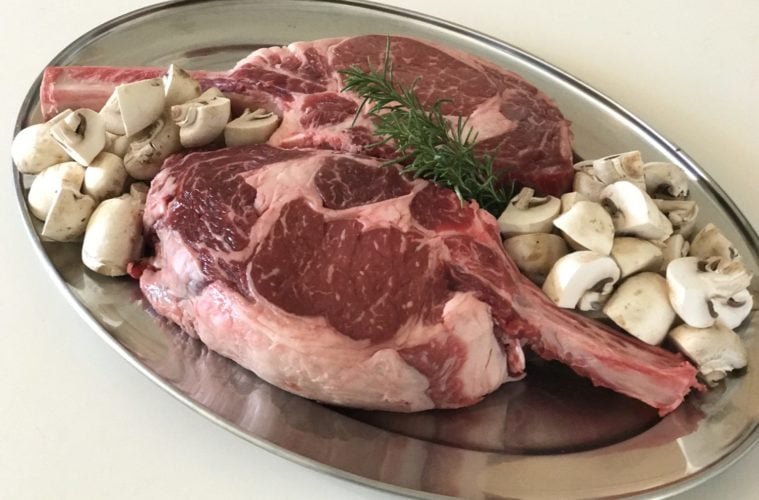Why cutting meat from the menu (or magazine) is misguided
Recently, beef has been portrayed as a bad actor in the fight against climate change. As a result, we’ve seen celebrated chefs, renowned restaurants and famed food publications cut beef in the name of saving the environment.
As a classically trained chef with more than 20 years of experience, it’s hard to not take announcements like this personally. We are trained to source ingredients responsibly, creatively fuse flavors and use techniques to introduce palettes to new ways of eating.
It would be really nice if the solution to climate change were as simple as turning our backs on a single ingredient. But it’s not. Beef plays an important role in sustainable eating, and it will continue to be a centerpiece of my cooking.
Cooking with meat, especially beef, has been a cornerstone of my cuisine for many years. After competing on and winning Food Network’s Vegas Chef Prizefight, I became the executive chef at Bugsy & Meyer’s Steakhouse inside the Flamingo Las Vegas Hotel and Casino. While there, I hand-picked local beef from the Las Vegas area, such as signature 32 oz Tomahawk Steaks, bone-in Ribeyes and we were one of only a few steakhouses on the strip with a signature Rib Cap. I take pride in working with local farmers and sourcing high-quality, sustainable beef from their family-owned businesses.
Beef has been a cornerstone of my restaurant concepts for years because I enjoy curating flavors that allow the beef to shine, while also encouraging guests to further appreciate the work of local farmers and ranchers. Featuring beef on the menu allows me as a chef to cook at the highest level possible, and to help erase any doubts diners may have about beef and its role in sustainability.
To suggest that banning beef is the silver bullet to save the planet is misguided. Beef in the U.S. is sustainably produced, and chefs and home cooks alike should feel good about continuing to enjoy it.1
Not only is beef’s environmental impact significantly smaller in comparison to transportation or electricity, but beef cattle actually benefit the environment in a big way. About a third of the land in the U.S. is not suitable for growing food crops, but it’s perfect for cattle to graze, turning grass and inedible plants into high-quality protein.
Plus, cattle contribute to a sustainable food system by enhancing the land they live on. They increase carbon storage, improve soil health, mitigate wildfires and provide habitat for wildlife.2,3,4 That means they help nurture land so other ingredients can grow and thrive.
As a chef, I take pride in my years of training and experience and I feel it is my responsibility to honor products, like beef, in my cooking. Part of honoring those products is learning about them and sourcing sustainable options – and thanks to beef farmers and ranchers, who also care about the land and the product, I feel good about cooking beef. I love to cook with a variety of ingredients and believe that chefs and home cooks alike should embrace the products available to them.
Frankly, it’s a pretty privileged perspective to cut meat at a time when malnutrition plagues people around the world, and data shows that countries with the lowest access to meat have the highest rate of nutrient deficiencies. A plant-only food supply would only make this worse. It means people would need to consume more calories but receive fewer nutrients from the food they eat.5,6,7 And right here in the U.S., maintaining a healthy, balanced diet when fresh food access is limited for certain communities is nearly impossible. The nutrients meat supplies are critical for diets, no matter your income, but especially so if you happen to live in a food desert.
Yes, both chefs and home cooks are interested in doing our part to help the environment but cutting beef – or any single ingredient for that matter – is not the answer.
Bottom line: beef is a wholesome, delicious, versatile protein that can be, and is, produced sustainably. Beef lends itself to endless flavors, cuisines and dishes and no matter what other recipe websites or restaurants choose to do, beef will always be on my menu.
- Herrero M, et al. Biomass use, production, feed efficiencies, and greenhouse gas emissions from global livestock systems. Proc. Natl. Acad. Sci. 2013. 110: 20888-20893
- Smith, P. 2012. Soils and climate change. Current Opinion in Environmental Sustainability 4: 539-544.
- Schuman, et al. 2002. Soil Carbon dynamics and potential carbon sequestration by rangelands. Environmental Pollution. https://www.onpasture.com/wp-content/uploads/2017/11/Soil-carbon-dymanics-and-potential-c-seq-by-rangelands.pdf
- Davies et al. 2005. Winter grazing can reduce wildfire size, intensity and behaviour in a shrub-grassland. International Journal of Wildland Fire. https://owri.oregonstate.edu/sites/agscid7/files/eoarc/attachments/854_winter_grazing_2015.pdf
- Development Initiatives, 2018. 2018 Global Nutrition Report: Shining a light to spur action on nutrition. Bristol, UK: Development Initiatives. https://globalnutritionreport.org/reports/global-nutrition-report-2018/burden-malnutrition/
- FAO, IFAD and WFP. 2015. The State of Food Insecurity in the World 2015. Meeting the 2015 international hunger targets: taking stock of uneven progress. Rome, FAO.
- McNeill S, Van Elswyk ME. Red meat in global nutrition. Meat Sci. 2012 Nov;92(3):166-73. doi: 10.1016/j.meatsci.2012.03.014. Epub 2012 Apr 1.
Advertising disclosure: We may receive compensation for some of the links in our stories. Thank you for supporting LA Weekly and our advertisers.

